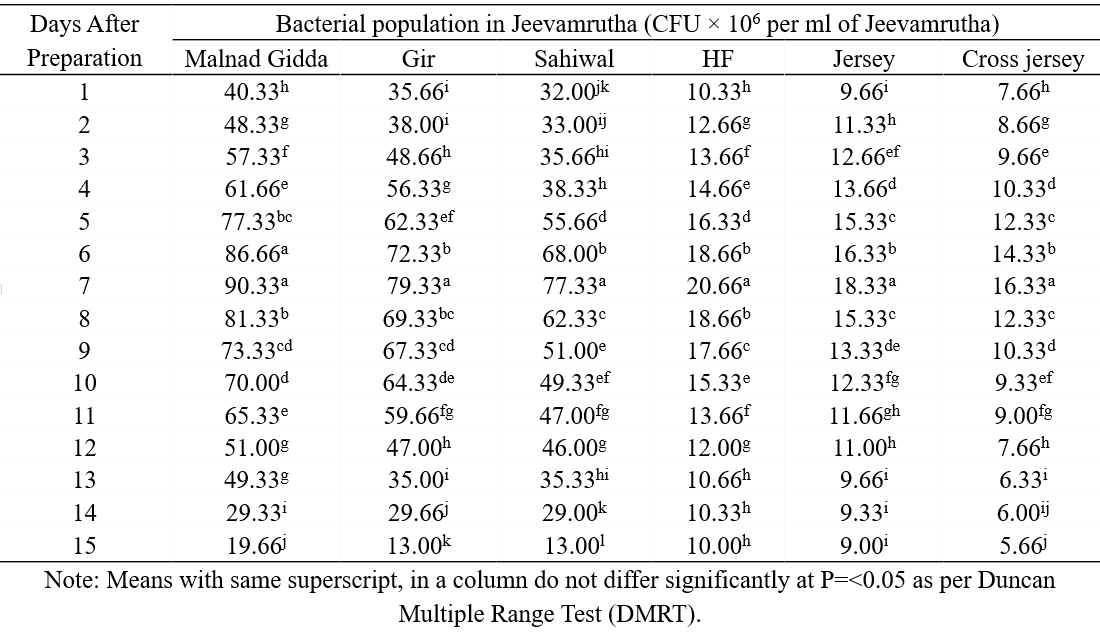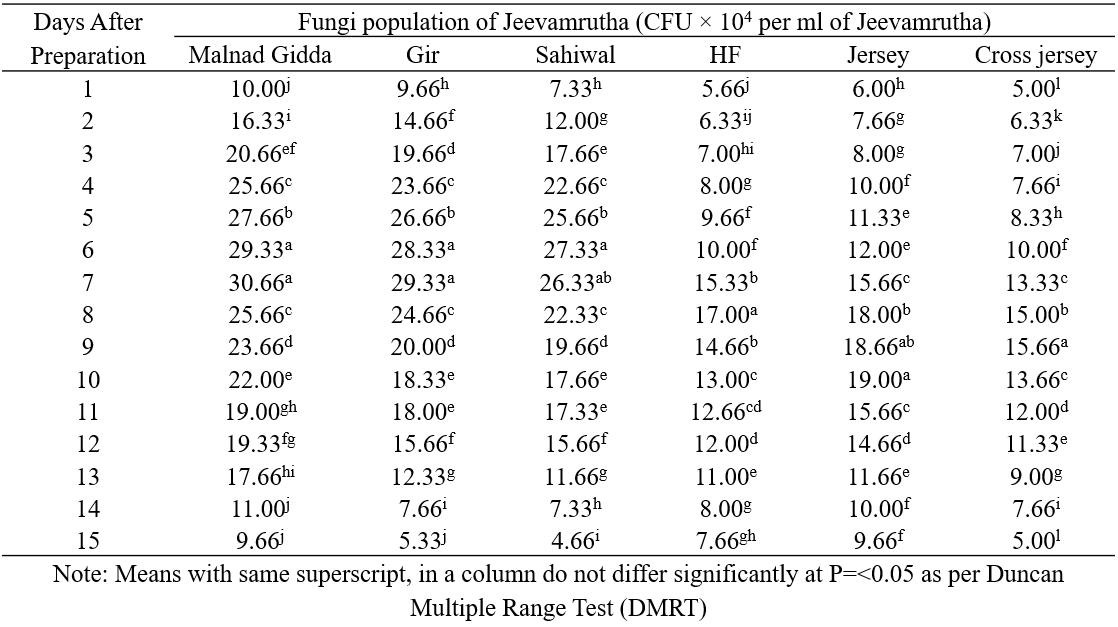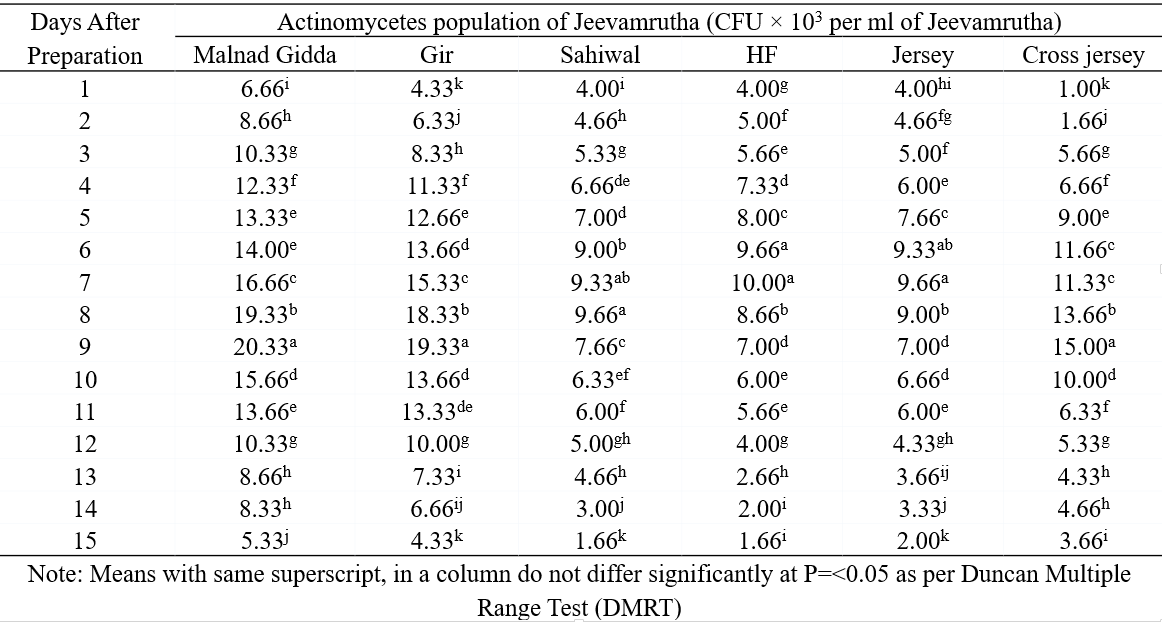Abstract
A laboratory experiment was conducted on shelf-life of jeevamrutha at Zonal Agricultural and Horticultural Research Station (ZAHRS), Brahmavar, Udupi. In this study three different desi breeds viz., Malnad gidda, Gir, Sahiwal and three different cross breeds viz., Holstein Friesian (HF), Jersey and crossbred Jersey, cow dung and cow urine were collected aseptically and separately to prepare Jeevamrutha, after preparation of Jeevamrutha from 1st day to 15th days samples were collected (daily) and enumerated the general microorganisms viz., bacteria, fungi and actinomycetes with their respective media. Among the desi and cross cow breeds jeevamrutha, desi cow breeds jeevamrutha contains higher microbial population compared to cross cow breeds jeevamrutha. In desi cow breeds jeevamrutha, Malnad gidda cow breed jeevamrutha contains the maximum microbial population. In general, the highest microbial population was noticed between 7th to 9th days after preparation (DAP) of jeevamrutha in all the cow breeds. Hence, it’s considered as a best time for the application of jeevamrutha to soil to improve the soil organic carbon.
Introduction
The cost of inorganic fertilizers is increasing enormously to an extent that they are out of to reach small and marginal farmers. Use of inorganic fertilizers and insecticides, the population of beneficial organism’s decrease and natural regeneration of nutrition in the soil cease (Rama and Naik, 2017; Dakshayini et al., 2016; Reddy et al., 2015). Soil becomes barren and soil fertility decreases. The use of fermented liquid manures in such situation is, therefore practically a paying proposal. Application of these organic liquid formulations will enhance the soil microbial activity and population to a larger extent. This in-turn has a positive effect on growth and yield of crops. Similarly, Subhash Palekar is one of the progressive farmers of Maharashtra, India; in his workshop on Philosophy and Technology of Zero Budget Natural Farming (ZBNF) he used a new biodynamic formulation termed jeevamrutha prepared from desi cow dung and cow urine. The desi cow or indigenous breed of cows is the backbone of ZBNF. For centuries, dung and urine from desi cows have been used in farming. Although the milk productivity of Indian cow breeds is low, they are very useful in production of cow dung and urine which will have a very high beneficial property. According to Subhash Palekar, one gram of desi cow dung contains 300 to 500 crore beneficial effective microbes as against 50 to 70 lakh microbes in cross bred cow dung. Hence, Cross bred jersey and Holstein Friesian (HF) cows should not be used in ZBNF (Palekar, 2006). Vanaja et al. (2009) stated that jeevamrutha is a plant growth-promoting substance containing beneficial microorganisms that provides the necessary nutritional requirement for growth and yield of a crop.
Cow dung was used as major ingredient for the preparation of jeevamrutha. It contains numerous microorganisms; they are Azotobacter, Acetobacter, Azospirillum (nitrogen supplier), Pseudomonas (phosphorus-solubilizer) and Bacillus silicus (potash-solubilizer) and others. Once jeevamrutha was incorporated to soil, these organisms are well activated and maintain the soil productivity. Manjunatha et al. (2009) reported that the use of jeevamrutha (indigenous species cow dung and cow urine, pulse flour, jaggery, rhizosphere soil solution) treated organics, improves the physico-chemical and biological properties of soil (Arpitha and Dakshayini, 2024), besides improving the efficiency of applied farmyard manure. They also confirmed that the potential of jeevamrutha is to supply materials and to act as food support for beneficial microbes.
Material and Methods
A laboratory experiment was conducted at Zonal Agricultural and Horticultural Research Station (ZAHRS), Brahmavar, Udupi.
Three desi cow breeds (Malnad Gidda, Gir and Sahiwal) and three cross cow breeds (Holstein Friesian (HF), Jersey and cross Jersey) were selected for the experiment.
2.1 Preparation of Jeevamrutha
All the cow breeds cow dung and cow urine was collected aseptically and separately to prepare Jeevamrutha, A standard procedure was used to prepare Jeevamrutha (Palekar, 2006); 1.25 kg of cow dung, 1.25 lit. of cow urine, 250 g of pulse flour, 250 g of jaggery, one handful of soil and 25 lit. of tap water were used to prepare 25 lit. of jeevamrutha. All the ingredients were mixed in a plastic bucket; the mouth of the bucket was covered with gunny cloth and the bucket was kept in the room temperature for 15 days. Each day the content was mixed thoroughly with a wooden stick and the sample was collected in a sterile polythene bottle to analyse the microbial population.
2.2 Microbial analysis
The biological properties such as total microbial population of bacteria, fungi and actinomycetes were analysed (Rama et al., 2015). The method advocated for the enumeration was serial dilution and plate count technique with appropriate medium. Enumeration of microbial population was carried out using Nutrient agar for bacteria, Martin’s Rose Bengal Agar (MRBA) for fungi, Actinomycetes selective media for actinomycetes at 106, 104 and 103 dilutions respectively and the plates were incubated at 28 ± 2 ºC.
2.3 Statistical analysis
The data obtained from experimentation were statistically analysed using completely randomized design (CRD). The statistical analysis was done by using WASP: 2.0 (Web Agri. Stat Package 2) statistical tool (www.icargoa.res.in/wasp2/index.php) and mean were separated by Duncan Multiple Range Test (DMRT).
Results and Discussion
The total microbial population viz., bacteria, fungi and actinomycetes, were significantly influenced by different storage days (1st day after preparation to 15th days after preparation). The pronounced increase in microbial population during ageing is clearly evident from Table 1, 2 and 3.
The higher microbial population were noticed in desi cow breeds jeevamrutha compared to cross cow breeds jeevamrutha. In desi cow breeds, maximum bacterial population were noticed in Malnad Gidda breed jeevamrutha (90.33 × 106/ ml of jeevamrutha) and the next best was Gir breed jeevamrutha (79.33 × 106/ ml of jeevamrutha). Among cross cow breeds, higher bacterial population were recorded in HF cow breed jeevamrutha (20.66 × 106/ ml of jeevamrutha), at 7th DAP of jeevamrutha. The population was gradually increased in the middle of storage (1st DAP to 7th DAP) and further decreased gradually (8th DAP to 15th DAP) in jeevamrutha, similar trend was observed in fungal population (Table 1 and 2).
Actinomycetes population was maximum on 9th DAP of jeevamrutha in all the desi breeds, however jeevamrutha prepared with Malnad Gidda (20.33 × 103/ ml of jeevamrutha) recorded the highest population of Actinomycetes compared to all other desi breeds of jeevamrutha at 9th DAP (Table 3). Radha and Rao, (2014) also reported the slow growth of actinomycetes in freshly prepared fermented liquid organic formulation compared to bacteria and fungi population. Devakumar et al. (2014) observed higher colony forming units of bacteria, actinomycetes, fungi and nitrogen fixers in Jeevamrutha at 7th DAP. Babu (2011) reported that uncountable rate of Bacillus. The higher microbial population of these liquid organic formulations made them as a potent source to maintain soil fertility and to enhance the nutrient availability by helping in faster decomposition of bulky organic manures (Kumar et al., 2023; Shilpa et al., 2015).
The over-all results reviewed that; the highest microbial population were observed between 7th to 9th days after preparation of jeevamrutha. Hence, it’s considered as a best time for the application of jeevamrutha, out of six cow breeds, jeevamrutha prepared with Malnad Gidda showed maximum microbial population compared to other cow breeds jeevamrutha. These microbes help to improve the plant growth by different mechanisms such as fixing of atmospheric nitrogen, solubilization of unavailable form phosphorus, potassium, zinc, organic matter decomposition etc., and also improve the soil fertility by increase with soil organic carbon.
Table 1: Bacterial population of Jeevamrutha prepared from dung and urine of different cow breeds

Table 2: Fungi population of Jeevamrutha prepared from cow dung and cow urine of different cow

Table 3: Actinomycetes population of Jeevamrutha prepared from dung and urine of different cow breeds

Acknowledgement
Special thanks to Natural Farming project funded by GOK grants, Department of Agriculture, KSDA, Karnataka and University of Agricultural and Horticultural Sciences, Shivamogga for providing the necessary facilities to carry out this study.
References
Arpitha P S and Dakshayini G. 2024. Exploring the impact of biofertilizers on Tomato crop growth and yield: A comprehensive research study. Current Innovation in Agriculture Science 1(1): 63-70
Babu S K. 2011. Microbial profile of value-added products from cow dung used for organic farming. M.Sc. Microbiology dissertation, University of Calicut pp. 54.
Dakshayini G, Reddy I B and Kammar S C. 2016. Evaluation of the Efficient Phosphate Solubilizing Bacteria on Growth of Chick Pea under Green House Condition. Advances in Life Sciences 5(2): 662-666.
Devakumar N, Shubha S, Gouder S B and Rao G G E. 2014. Microbial analytical studies of traditional organic preparations Beejamrutha and Jeevamrutha. In: Rahmann, G and Aksoy, U (eds.), Building Organic Bridges. Proceedings of the 4th ISOFAR Scientific Conference Istanbul, Turkey pp. 13-15.
Kumar Naik A H, Shivanand G, Govinda K, Anantha Rama A, Divyajyothi U, Sujatha S and Pallavi M. 2023. Performance of maize (Zea mays) + field bean (Dolichos lablab) intercropping system under natural, organic and conventional farming practices. The Indian Journal of Agricultural Sciences 93(9): 1007-1012. Doi: https://doi.org/10.56093/ijas.v93i9.136842
Manjunatha G S, Upperi S N, Pujari B T, Yeledahalli N A and Kuligod V B. 2009. Effect of farm yard manure treated with jeevamrutha on yield attributes, yield and economics of sunflower (Helianthus annuus L.). Kar. J. Agril. Sci., 22(1): 198-199.
Palekar S. 2006. Three-day workshop on Philosophy and Technology of Zero Budget Natural Farming, Organized by the Karnataka Rajya Raitha Sangha (KRRS) and HasiruSene. Arsikere, Hassan (Dist), India. Available online. http://srinidhifarm.com/zerobudgetfarming.php.
Radha T K and Rao D L N. 2014. Plant growth promoting bacteria from cow dung based biodynamic preparations. Ind. J. Microbiol. pp. 1- 6.
Rama A A, Mahadevaswamy K, Naik N and Kuruber A R. 2015. Influence of Efficient Strain of PSB on Growth and Yield of Maize (Zea mays L.) Under Black Cotton Soil Condition. Journal of Pure and Applied Microbiology 9(2): 1179-1184.
Rama A A and Naik L K. 2017. Effect of Biocontrol Agents and PGPRs on Growth and Yield of Okra under in vitro Condition. Mysore J. Agric. Sci. 51(2): 347-353.
Reddy I B, Chaithra B M, Kammar S C and Dakshayini G. 2015. Studies on effect of PGPRs and organic matter on growth and biomass of Morinda citrifolia L. Trends in Bioscience 8(23): 6728-6730.
Shilpa M E, Latha B, Dakshayini G, Vikas H M and Srikantaiah M. 2015. Effect of microbial inoculants on growth and yield parameters in sunflower (Helianthus annuus). Journal of Pure and Applied Microbiology 9(3): 2591-2596.
Vanaja R, Srikanthamurthy H S, Ningappa K, Shivakumar, Nagaraju B, Ningaraju, Shashidhara, Doddappa, Vijay A R, Shivanna M, Obanna N, Pandu A C, Rama S, Sandhya M, Veena P and Suma S. 2009. Sustainable Agricultural Practices, Green Foundation, Bangalore pp. 52.
Copyright
Open Access This article is licensed under a Creative Commons Attribution 4.0 International License, which permits use, sharing, adaptation, distribution and reproduction in any medium or format, as long as you give appropriate credit to the original author(s) and the source, provide a link to the Creative Commons license, and indicate if changes were made. The images or other third party material in this article are included in the article’s Creative Commons license, unless indicated otherwise in a credit line to the material. If material is not included in the article’s Creative Commons license and your intended use is not permitted by statutory regulation or exceeds the permitted use, you will need to obtain permission directly from the copyright holder. To view a copy of this license, visit http://creativecommons.org/licenses/by/4.0/.

